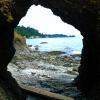January 30, 2015 - 23:07

For my scape I chose a place that is part of one of my favorite parts of campus but also contradicts it. The row of oaks making up senior row is abruptly broken by an American Beech about two-thirds of the way down that isn’t part of the “row” proper. You can’t see in this picture because the foliage is plentiful, but beneath and around this tree sit two benches and two perpendicular pieces of fence that don’t actually fence anything in. It forms such an odd space, especially compared to neatly aligned trees next door.

From the sprawling roots, the benches, or even perched on a fence, visible are the valley of death, Cambrian Row, Park Science, Radnor, Campus Center, Merion, Canaday, and Senior Row, not to mention the pathways and greens connecting them. I think it will be interesting to observe not only this unconventional and not entirely purposefully designated patch of campus, but also the vast array of campus life that surrounds it.
When I found my scape, I knew it was the right fit. I could shift my lenses, looking directly at campus or beyond it. The crisscrossing branches of the tree gave me a reference point. I stood there, looked up, and watched the moon stay put relative to the silhouettes of the branches. Now, I know the moon doesn’t stay put. It orbits Earth, as we all orbit a large star. To contrast, I also sat solidly on the bulbous roots and craned my next skyward. If I didn’t move for a few minutes, I could watch the moon move relative to the branches. I wasn’t sure how to capture this sensation, of how something as simple as the night sky can instantly ground and free you. I find it fairly easy to think big. I think that the hardest part is not getting lost in it. It’s always necessary to pull something into focus, give yourself a reference point, and ignore the rest for a while, and in this space, the possibilities for where that focus may land are wide open.
